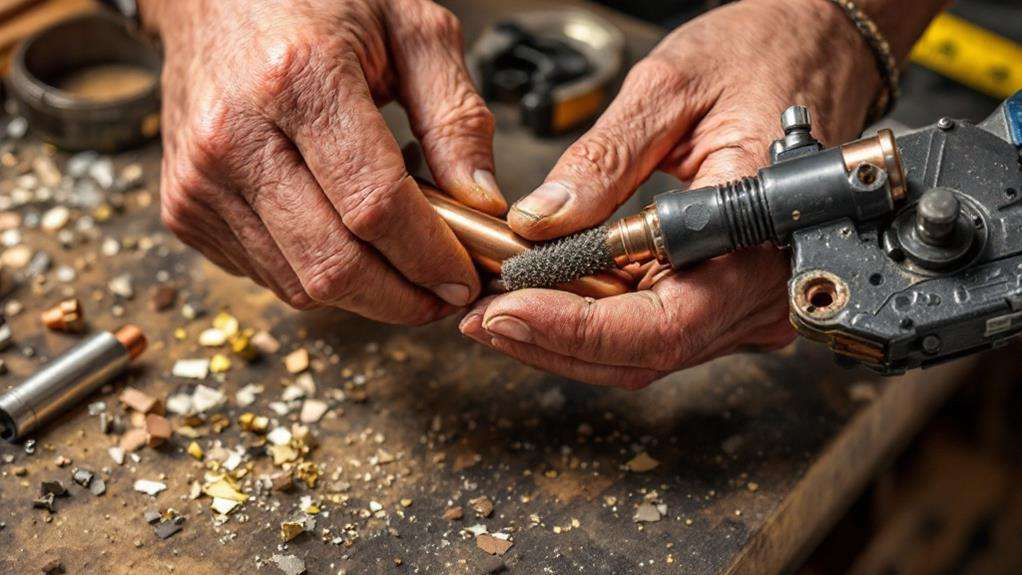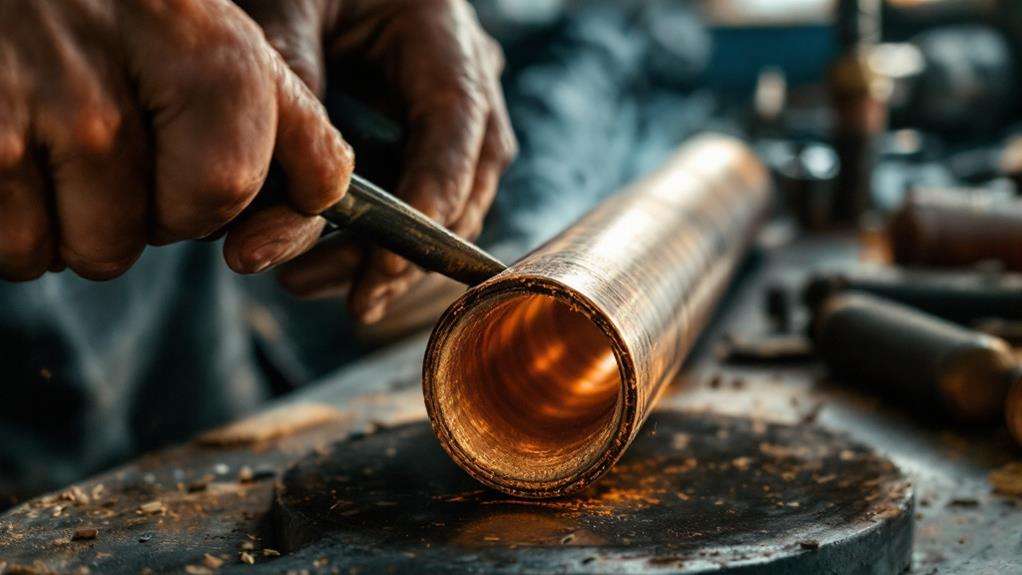How to Use a Pipe Reamer: An Essential Tool for Clean Cuts
To use a pipe reamer effectively, start by selecting the right size for your pipe bowl. Verify your pipe is cool and clean before beginning. Insert the reamer gently into the bowl and rotate it to remove excess cake buildup. Work gradually, starting with the smallest reamer head and increasing as needed. Aim for a cake thickness of 1/16 to 1/8 inch, maintaining a consistent taper. Be careful not to ream down to the briar. After reaming, clean your pipe thoroughly and allow it to cool before storing. Proper technique and regular upkeep will vastly extend your pipe's lifespan and enhance your smoking experience.
Understanding Pipe Reaming Basics
Pipe reaming is a pivotal skill for pipe smokers to acquire. It's an indispensable maintenance task that helps preserve the ideal smoking characteristics of your pipes and extends their longevity. Every pipe requires periodic reaming to prevent excessive cake buildup, which can narrow the bowl, reduce tobacco capacity, and alter smoking characteristics.
Understanding the basics of pipe reaming is imperative for proper pipe care. The process involves carefully removing the accumulated cake layer inside the bowl, using specialized tools like the Castleford 5-piece multi-fit tobacco pipe reamer. These tools come in various sizes to accommodate different pipe bowl dimensions and allow for gradual cake removal.
When reaming, you'll want to start with smaller sizes and work your way up, checking your progress regularly. The goal is to remove cake down to the heel of the bowl without damaging the underlying briar. Regular reaming improves airflow, reduces the "chimney effect," prevents overheating, and enhances your overall smoking experience.
Selecting the Right Reamer
When it comes to selecting the right reamer, you'll want to prioritize versatility and precision. Choose a pipe reamer set with multiple interchangeable heads to accommodate different sized pipe bowls. This proper reamer selection guarantees you'll have the right tool for various pipes in your collection.
To achieve the best results, match the reamer head diameter to the interior dimensions of your pipe bowl. This snug fit allows for a precise and effective reaming process. Start with the smallest reamer head and gradually increase the size to remove cake buildup efficiently. This approach helps you maintain control and achieve the ideal reaming speed without damaging your pipe.
Opt for a high-quality reamer tool, such as the Castleford 5-piece multi-fit set, to ensure durability and smooth operation. When comparing reamer heads, look for ones that offer a range of sizes to suit your needs. Additionally, select a reamer with a comfortable handle to maintain control and prevent potential damage to the pipe's briar during the reaming process. By choosing the right reamer, you'll be well-equipped to maintain your pipes effectively and extend their lifespan.
Preparing Your Pipe

Three essential steps will prepare your pipe for reaming. First, guarantee your pipe has cooled completely. This is pivotal for safety and to prevent any damage to the pipe or reamer during the process. A cool pipe also allows for better visibility of the residue buildup, which is indispensable for effective cleaning.
Next, conduct a thorough residue inspection. Examine the pipe bowl carefully to assess the extent of the cake buildup. This step helps you determine the appropriate reamer size and the level of cleaning required. Look for any uneven areas or particularly thick deposits that may need special attention.
Step-by-Step Reaming Process
With your pipe and reamer ready, it's time to begin the actual reaming process. Start by selecting the smallest reamer head that fits snugly into your pipe bowl. Gently insert it and rotate to remove the built-up cake. As you progress, gradually increase the reamer size to maintain a consistent taper throughout the bowl.
Your goal is to ream down to the heel of the bowl without reaching the Briar. This careful approach preserves your pipe's smoking characteristics while ensuring essential airflow maintenance. As you work, occasionally use the narrower reamer to smooth out any imperfections on the sides of the bowl. This step is indispensable for creating a uniform interior, which enhances your smoking experience.
Monitor your pipe's condition regularly and perform reaming when the cake becomes noticeable. Avoid letting excessive buildup occur, as this can potentially damage the Briar. For the best results, invest in quality reaming equipment like the Castleford 5-piece multi-fit tobacco pipe reaming tool. Proper reamer size selection and technique will improve your pipe maintenance routine and extend the usable lifespan of each pipe in your collection.
Maintaining Proper Cake Thickness

Maintaining the proper cake thickness is a critical aspect of pipe care. As an experienced pipe smoker, you'll want to aim for an ideal cake thickness of 1/16 to 1/8 inch. This range provides the best balance between optimal smoking characteristics and briar protection. A cake that's too thick can narrow your bowl, reducing tobacco capacity and altering your smoking experience. On the other hand, a cake that's too thin may not adequately safeguard the briar, potentially leading to cracking or damage.
To guarantee proper cake formation and maintenance, follow these steps:
- Regularly inspect your pipe's cake thickness
- Use a pipe reamer, such as the Castleford 5-piece multi-fit set, to trim excess cake
- Clean your pipe thoroughly after each use to promote even cake formation
Aftercare and Storage Tips
After you've properly maintained your pipe's cake, it's time to ponder how you'll care for and store your pipe between uses. Proper storage conditions are essential for preserving your pipe's longevity and ensuring a pleasant smoking experience. Always let your pipe cool completely before storing it to prevent moisture buildup. Store your pipe in a dedicated rack or holder, keeping it upright to allow any residual moisture to drain.
Implement regular cleaning procedures to maintain your pipe's performance. After each use, run a pipe cleaner through the stem and bowl to remove debris and moisture. For a deeper clean, use a specialized pipe cleaning solution monthly. Don't forget to clean your pipe reamer too, wiping it down with a soft cloth after each use.
Conduct periodic inspections of your pipe to catch any potential issues early. Check for cracks, loose stems, or excessive cake buildup. If you notice any problems, address them promptly to prevent further damage. By following these aftercare and storage tips, you'll extend your pipe's lifespan and enjoy consistent, high-quality smokes for years to come.
